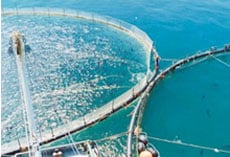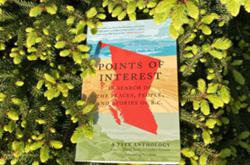
Fish farming has long been viewed as a way to help fill dinner bowls worldwide while easing the pressure on declining populations of wild ocean fish. Now the U.S. aquaculture industry is poised to shed its coastal cloak to farm deeper waters. Last week, the Bush administration has sent a bill to Capitol Hill that would open 3.4 million square miles of ocean -- roughly the land area of the lower 48 states -- to fish farms.
The bill would allow the U.S. secretary of Commerce to issue permits for fish farms in federal waters, up to 200 miles offshore.
The proposed legislation represents the latest effort to implement recommendations from the U.S. Commission on Ocean Policy, which last fall sent the White House its blueprint for overhauling the approach the country takes to managing its vast offshore resources. It also represents the start of a process that will give various "stakeholders" -- including the aquaculture industry, environmental groups, state and local officials -- an opportunity to help shape the rules, federal officials say. "Our goal is to develop a sustainable aquaculture program that balances the needs of fishermen, coastal residents and visitors, seafood consumers, the environment, and the aquaculture industry," said Conrad Lautenbacher Jr., administrator of the National Oceanic and Atmospheric Administration (NOAA), in a prepared statement.
Nutrition meets scarcity
The measure comes at a time of rising global demand for fish as a source of dietary protein, declining fisheries, and rising aquaculture efforts overseas. By 2030, less than half of the fish humans consume will come from wild stocks, according to United Nations estimates. Aquaculture will dominate. Global consumption is expected to reach 110 million metric tons of fish within the next five years.
In the US, "nutritionists are asking us to eat twice as much seafood as we do," says Michael Rubino, manager of NOAA's aquaculture program. "At the moment we import 70 percent of our seafood, and wild fisheries won't be able to meet future market demand. So any increase in supplies is coming from aquaculture. The question is, do we keep importing it, or do we produce some domestically?"
Currently, the U.S. consumes 6 million metric tons of fish a year. By 2025, US consumption is expected to grow by another 2 million metric tons.
"If we could produce that here, that would create 500,000 direct jobs, and 100,000 or more indirect jobs, and contribute about $5 billion in revenue," Dr. Rubino says.
The bill would allow NOAA to issue two permits -- a site permit and an operating permit -- for 10 years. Operators could renew their permits in five-year increments. To receive the permits, fish farmers would have to meet a number of requirements that deal with issues such as environmental monitoring and quality, and business practices. "Those details would be worked out in the regulatory-design process," Rubino says.
And it's designed to push the state of the art in technologies that allow for more environmentally sustainable aquaculture in the open ocean. Indeed, he says, it contains strong language regarding environmental stewardship and public input.
The move to open oceans to fish farming is attractive for several reasons, some analysts say. It moves fish farms away from the coast, where plumes of pollution from urban runoff can endanger the "herd." And it can make siting a farm somewhat easier, since it would draw less opposition from local residents uneasy about the potential for aquaculture pollution -- in the form of waste from the fish -- to foul beaches.
Voracious carnivores
Some environmentalists and marine researchers view open-ocean fish farming with a wary eye. They are concerned that because open-ocean farming is out of sight, it may slowly fall out of mind. Many of the species to be kept down on the aquafarm are top-of-the-food-chain meat eaters, which have the highest market value. But they also are voracious, requiring anywhere from three to 25 pounds of feed -- read smaller fish or fish meal -- for every pound of meat in the farmed species. Concerns also have been growing over the spread of parasites, such as sea lice, from farmed fish to wild schools that pass by, as well as over the results of genetic mixing between wild fish and their escaped farmed cousins.
Sustainable aquaculture is possible if the right species and techniques are used, says William Mott, outgoing president of SeaWeb, a nongovernmental organization that supports sustainable aquaculture. If the motive truly is to meet demand for food, he says, more can be done with fresh-water species grown in urban areas close to their markets, rather than developing large marine feedlots offshore.
Citing unease at what he sees as a bill crafted with input dominated by the aquaculture industry, Mr. Mott adds that it's important to get the measure right. "This legislation will set precedents for generations."
Peter N. Spotts is a staff writer for the Christian Science Monitor. © 2005 Independent Media Institute. All rights reserved. ![]()














Tyee Commenting Guidelines
Comments that violate guidelines risk being deleted, and violations may result in a temporary or permanent user ban. Maintain the spirit of good conversation to stay in the discussion.
*Please note The Tyee is not a forum for spreading misinformation about COVID-19, denying its existence or minimizing its risk to public health.
Do:
Do not: